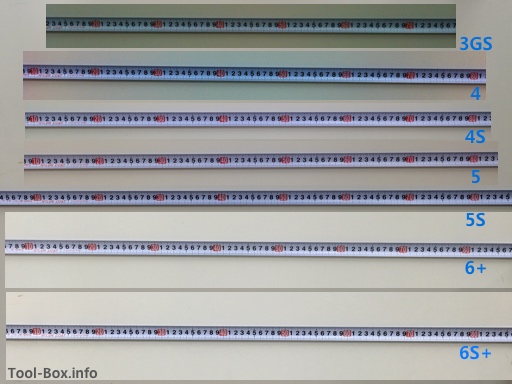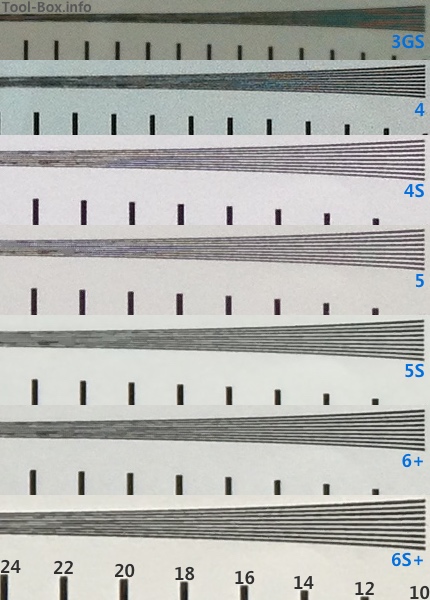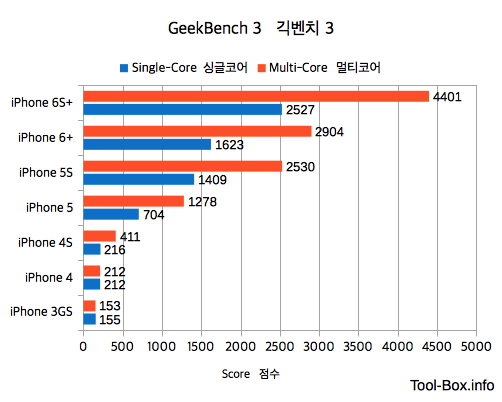Comparing 7 iPhones: Camera (Technical)
Posted by Wesley on
Checking the iPhone cameras' field of view
One of the things I've noticed about the iPhone's camera is that its field of view seemed to change with each generation, especially in the early days. This meant that the focal length was different. While the EXIF data does show the 35mm equivalent focal length, I wondered if this was really accurate. I wanted to check this out before doing deeper comparison.
| Device (Orig. Photo) |
Focal Length (Actual mm) |
35mm Equiv. (Reported) |
35mm Equiv. (Measured) |
|---|---|---|---|
| iPhone 6S+ | 4.15 | 29 | 30.2 |
| iPhone 6+ | 4.15 | 29 | 30.1 |
| iPhone 5S | 4.15 | 29 | 30.0 |
| iPhone 5 | 4.12 | 33 | 32.2 |
| iPhone 4S | 4.28 | 35 | 32.8 |
| iPhone 4 | 3.85 | 35 | 33.2 |
| iPhone 3GS | 3.85 | 35 | 37.2 |
By taking photos of a tape measure from a set distance and calculating the focal length with a formula, this is what I got. The last three generations have been stable - they all report 29mm, and the actual measurements are nearly the same at around 30mm. For the three generations before that, the measured values are around 32 to 33mm, although the reported values exceed this by a mm or two.
Interestingly, 3GS has the longest focal length of all at about 37mm. It isn't particularly good for selfies or group photos, and since it didn't have a front-facing camera, this was doubly unfortunate. As the selfies and wide-angle lenses became popular, perhaps Apple saw this as a problem and kept reducing the focal length until iPhone 5S in addition to adding the front-facing camera.

ISO 12233:2000 resolution measurements with iPhone cameras
Now I decided to figure out the optical resolutions of the iPhone cameras. This is done by using the ISO 12233:2000 chart and looking at the test lines to see how far each of the lines remain distinguishable. I've done this test five years ago with 3GS, and I had promised to revisit it with newer iPhones. It's rather long overdue, but it's definitely worth it.
Considering the processing done to the output photos, conventional sensors would be alright with Lines per Picture Height (LPH) being 65% or greater of the sensor resolution. Let's see how the iPhones have progressed throughout the years. The photos were taken in a sufficiently well-lit room so that the lowest ISO setting would automatically be chosen by the default camera app.
| Device (Orig. Photo) |
Vertical Pixel Count | Vertical LPH (Resolution) | Percentage |
|---|---|---|---|
| iPhone 6S+ | 3,024 | 2,000 | 66% |
| iPhone 6+ | 2,448 | 1,700 | 69% |
| iPhone 5S | 2,448 | 1,700 | 69% |
| iPhone 5 | 2,448 | 1,800 | 74% |
| iPhone 4S | 2,448 | 1,800 | 74% |
| iPhone 4 | 1,936 | 1,400 | 72% |
| iPhone 3GS | 1,536 | 1,000 | 65% |
Sharpening applied to the image processing during the iPhone 4 to 5 eras have apparently enhanced the percentage slightly, while the more recent ones have toned this down and still maintained the numbers in the high 60s. So it seems that the optical resolution has been kept up with the increase in the sensor's pixel count more or less. It does seem that, to go beyond 12 megapixels used in 6S Plus, Apple may need to opt for a sensor size increase to avoid degradation in quality.
